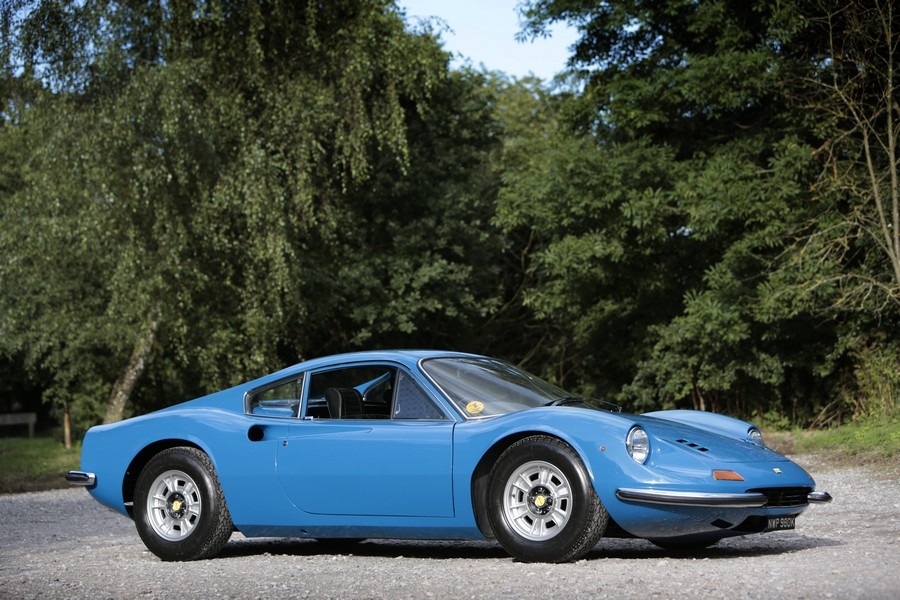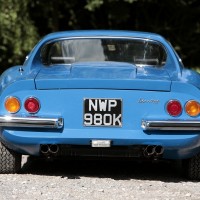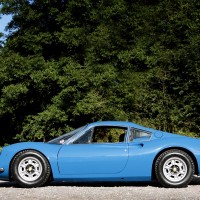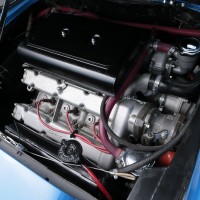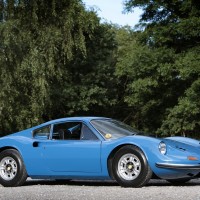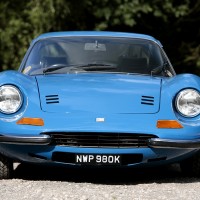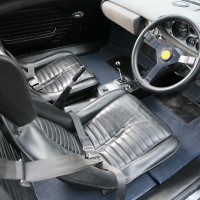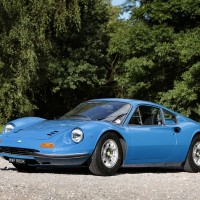SCM Analysis
Detailing
| Vehicle: | 1972 Ferrari 246 GT Dino Berlinetta |
| Number Produced: | 2,609 (246 GT) |
| Original List Price: | $14,700 (1972) |
| Tune Up Cost: | $3,500 |
| Distributor Caps: | $380 |
| Engine Number Location: | Side of block before oil filter |
| Club Info: | Ferrari Club of America, Ferrari Owners Club |
| Website: | http://www.ferrariclubofamerica.org |
| Investment Grade: | B |
This car, Lot 216, sold for $378,059, including buyer’s premium, at Bonhams’ Goodwood Revival auction on September 14, 2013.
After considerable study on the subject, I’m still not sure exactly what a Dino is. In his book, Dino: The Little Ferrari, Doug Nye lists 30 different Dino variations without breaking them down into coupe and open-top models. Nye includes the Fiat Dinos and the Lancia Stratos, and if you follow his logic, they probably should be included.
It is generally thought that Enzo Ferrari’s son Dino designed the 6-cylinder engine that was used in Ferrari race cars and later in Dino production cars. While Dino had a part in the development of the 6-cylinder engine, his contribution was small.
The 6-cylinder idea surfaced in the winter of 1955–56, when Enzo and the great engine designer Vittorio Jano would visit the gravely ill Dino and discuss possible engine designs for a new Formula 2 series. Ferrari’s V12 engines were too big for the series, and a smaller unit was needed. Designs of 4-, 6- and 8-cylinder engines were discussed, and Dino was credited for championing the V6 design that was eventually chosen. Jano designed and developed the new V6 engine mostly after Dino’s death.
What’s in a name?
The first Dinos were formula race cars, and they raced as Ferraris with a Ferrari nose badge and Scuderia shields. The new V6 was identified with the word “Ferrari” cast in the cam covers. It was only later — and without fanfare — that the engine was rebadged as a Dino.
Early Dinos are best described as Ferrari/Dinos, much like we see in Lotus/Ford. They were Ferraris powered with Dino engines. Dino engines were designed and built in house by Ferrari employees. The Dino name was an honor rather than a separate business.
Dino engines were made in several different displacements, several different degrees of Vs and with 2- and 4-cam heads. They were also used in the Fiat Dinos and the Lancia Stratos. Some rally versions of the Stratos even had 4-valve heads and turbochargers.
Along with Dino engines, Ferrari also produced cars totally badged “Dino.” These included Formula race cars, sports racers, and the 206/246 production series. They were produced by Ferrari and their suppliers. They were marketed and supported exclusively by Ferrari, and any illusion that they were anything less than a true Ferrari is wrong.
Values rising fast
Less than two years ago, the Dino world was rocked with the sale of a yellow 246 GTS. The car had been bought a few months before for a little over $200,000, which was market-correct. It went to auction with an ambitious $250,000–$325,000 estimate. Then it blew the roof off with a logic-defying $363,000 sale. Rather than an aberration, the sale became a bellwether for Dino values, which now can get up to the half-million-dollars mark.
The closed-top GT has always trailed the open-top GTS in value. This is partly because of the natural tendency for open cars to have higher values, but also because most GT models had fewer options. Most 246 GTS cars will have a/c, electric windows and leather interior, while it is not unusual to find a GT with a vinyl interior, crank windows, and no a/c.
Some past issues?
Our subject Dino did not look like a car that was worth a big stretch. It was a non-air-conditioned, vinyl-interior version with electric windows. The blue color was a refreshing change from red — but not one that many people would really buy.
If you’re not familiar with the term SORNed, it stands for Statutory Off-Road Notification. It is used to cancel the registration of a vehicle. SORN is a pretty drastic move, and it suggests some problem that might have been thought terminal when Dinos were worth much less. Indeed, the seller spent more than $100k getting the Dino back on the road.
Even after a $100k refit, a quick glance showed the wrong steering wheel, incorrect engine compartment detailing and a missing spare tire hold-down. These problems could have easily been corrected with off-the-shelf parts. They raise the question of what else was skipped.
The Bonhams sale is a continuation of the silliness that the Ferrari market is experiencing. The car sold well above its value. I would have called it shockingly high two years ago, but I’m getting so used to goofy prices that I’ve been numbed. I’ve finally accepted that there are a lot of very wealthy people competing for few cars, and Ferrari sale prices have little to do with traditional valuation.
In the classic Ferrari market, sellers are demanding prices that are higher than the last one sold. Buyers have to pay the tariff if they want to buy a car. Most current buyers aren’t hard-core enthusiasts who have traded and saved to buy the car of their dreams. They are wealthy collectors who already have a few cars, and if they overpay, it’s not going to hurt them.
Dino 03672 rang the bell for Dino coupes. It was an extremely high price for a less-than-top example. Yes, a lot of money had been spent on the car, but that’s because it needed a lot of money spent on it.
The seller got all the money and should be delighted. The buyer could have gotten better for less. The Dino market is moving quickly, but this buyer was well ahead of the bar. ♦
(Introductory description courtesy of Bonhams.)
